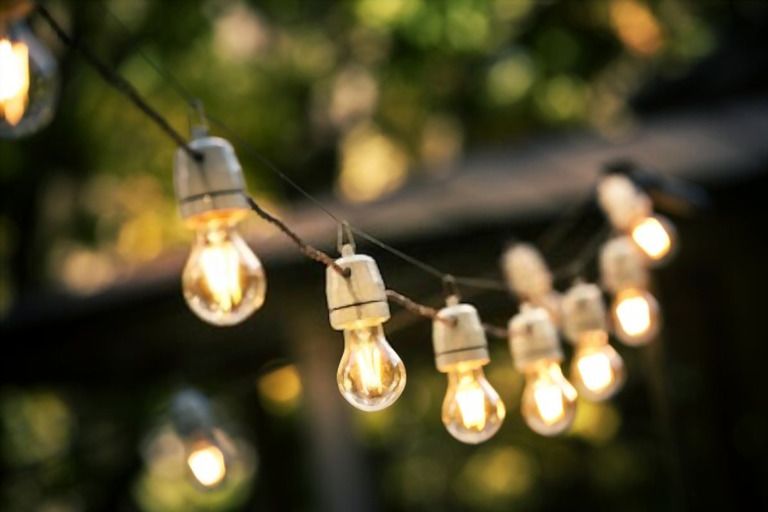
Outdoor lighting is important for safety and illumination at night, whether you’re relaxing in the backyard or going home late at night. For that reason, finding the right types of outdoor light bulbs is essential.
But first, you should understand the use, pros, and cons of each type.
LED - Light Emitting Diode

Start with LED lights!
You can find a wide range of LED lighting forms, such as motion sensor security lights, wall-mounted fixtures, and street lighting.
Unlike other types, LEDs are durably made from heavy-duty materials that can bear tough weather conditions. This also leads to the fact that LED lights last really long – usually within 30,000 to 50,000 hours.
The best thing is they don’t need time to heat up then turn on like the traditional bulbs, which means they can be instant-on, even in frost-bite weather conditions.
Making them really stand out from other outdoor lighting types is energy efficiency.
While using hugely less electricity, it shines brighter than the incandescent or halide bulbs, equivalent to more lumens delivered per watt.
Another reason making LEDs a perfect choice for outdoor use is its brighter white glow for better illumination.
Nowadays, outdoor LED lights are commonly used to illuminate walkways, steps, spools, or spice up outdoor dining, spotlight something special and add some colors. Besides, it helps increase the security and safety of your outdoor space throughout the night.
CFL - Compact Fluorescent Lamps

What makes this lighting type ideal for outdoor use are:
- Low heat radiating
- Low operating cost
- Easy to retrofit
- Dimmable
- Various shapes and sizes
- Long-lasting durability
- Provide and remain good brightness
In comparison to the incandescent bulbs, CFLs use 50% to 80% less energy, meaning for up to 4 times more efficient. Despite the expensive price points, it is extremely economical in the long run.
You can replace a 100W incandescent bulb with a 22W CFL while receiving the same illumination level. Besides, using CFLs helps reduce carbon emissions.
If you’re wondering about its longevity, a CFL light can last 8,000 to 10,000 hours of use.
Not all CFLs can be used outdoors so before choosing one, it’s important to check the maximum temperature it can handle. It would be best if the bulb can hold up well below 0 degrees Fahrenheit. Find this indicator on the product’s label or packaging.
Fluorescent Lights

Fluorescent lights were developed by four scientists in 1934 at GE with the aim to provide eco-friendlier operation at a longer lifespan and lower maintenance costs than incandescent lights.
Additionally, the pro circuit allows fluorescent lights to shine brighter than the traditional bulbs.
According to the US Department of Energy, a fluorescent bulb consumes around 25% to 35% less energy than a conventional light. That means a 75W incandescent bulb and a 20W fluorescent model offer the same brightness level.
While helping you save more money on monthly electricity bills, the lower energy consumption of this lighting type makes it cooler to last longer – up 10,000 hours.
Fluorescent lights don’t require much time and effort on maintenance as well.
They don’t require you to replace them as frequently as using the convectional lights so that you can rest assured to install them in harder-to-reach spots.
Moreover, according to Energy Star, using a fluorescent light helps you save up to $40 and it can last up to 6 months.
Halogen Lights

A halogen bulb can be used outdoors as long as it is enclosed in outdoor-rated fixtures or has a heavy glass – like halogen PAR lamps - to tolerate the thermal shock of rainwater.
Although halogen lights aren’t as energy-efficient, cool, and long-lasting as the fluorescent lights, CFLs, or LEDs, they’re better than the incandescent bulbs.
Halogen lights are commonly used as floodlighting or spotlighting.
Incandescent Lights

Last but not least, we’ve got the incandescent lights.
As stated above, they’re the least energy-efficient lighting type in this list but on the bright side, their initial price point is very budget-friendly.
It also features a simple construction to pair with motion sensors, photocells, or timers to work as a porch lamp or motion-detecting light. It is something that such complicated lights like fluorescent or CFLs are hard to do.

If you plan to use it outdoors, take note that this type can’t be exposed to weather elements like sun, rain, snow, or storm. It would be perfect to be mounted under the eaves or canopy in those living areas with warm to cool weather conditions.
Make sure the light is rated for outdoor use – or UL listed – as well.
Conclusion
A well-lit landscape and yard prevent unwanted guests from coming into your property.
There are numerous types of outdoor light bulbs out there with specific uses, strengths, and weaknesses. Each of them is just ideal to use in specific conditions or a certain group of people.
Before choosing some, understanding their uses and applications will help you optimize the initial expenses while using them more effectively.













